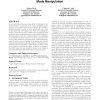Free Online Productivity Tools
i2Speak
i2Symbol
i2OCR
iTex2Img
iWeb2Print
iWeb2Shot
i2Type
iPdf2Split
iPdf2Merge
i2Bopomofo
i2Arabic
i2Style
i2Image
i2PDF
iLatex2Rtf
Sci2ools
ICMI
2007
Springer
2007
Springer
A study on the scalability of non-preferred hand mode manipulation
In pen-tablet input devices modes allow overloading of the electronic stylus. In the case of two modes, switching modes with the non-preferred hand is most effective [12]. Further, allowing temporal overlap of mode switch and pen action boosts speed [11]. We examine the effect of increasing the number of interface modes accessible via non-preferred hand mode switching on task performance in pen-tablet interfaces. We demonstrate that the temporal benefit of overlapping mode-selection and pen action for the two mode case is preserved as the number of modes increases. This benefit is the result of both concurrent action of the hands, and reduced planning time for the overall task. Finally, while allowing bimanual overlap is still faster it takes longer to switch modes as the number of modes increases. Improved understanding of the temporal costs presented assists in the design of pen-tablet interfaces with larger sets of interface modes. Categories and Subject Descriptors H5.2 [Infor...
| Added | 08 Jun 2010 |
| Updated | 08 Jun 2010 |
| Type | Conference |
| Year | 2007 |
| Where | ICMI |
| Authors | Jaime Ruiz, Edward Lank |
Comments (0)

